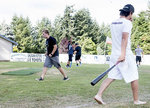
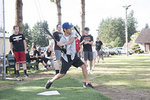
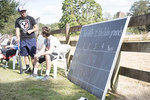
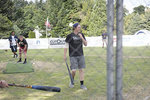
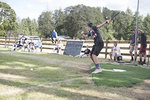
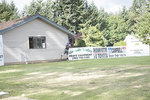
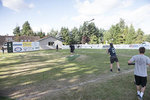
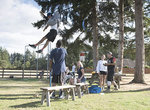
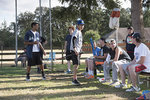

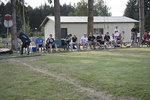


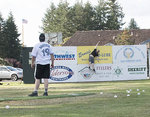
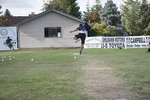
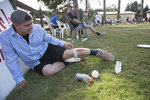
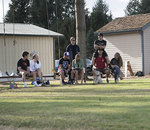



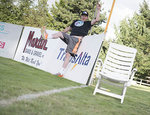
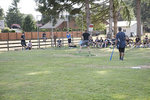


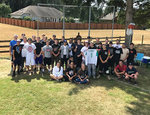
Everything you could ever possibly need to know about Centralia Wiffleball can be gleaned from the program.
Yes, the 10th and perhaps final competition (proper name: Max & Joe’s 10th Annual Wiffleball Tournament) of the Hub City’s most illustrious wiffleball organization featured an official program. The lovingly curated 24-page history of the league — complete with group photos and results from each of the past nine tournaments, a record book, biographies on 24 of its most noteworthy players, and the occasional off-color story — was produced by president and founder Max Dulin and printed, mostly in color, on heavy-stock paper.
Dulin spent somewhere around two months compiling his magnum opus, copies of which should be cherished and saved for generations. That so much work would be put into preserving the history of what is, essentially, a formalized tournament featuring a bunch of kids messing around in the back yard is exactly why it’s lasted a full decade.
“It’s just fun,” Centralia Wiffleball co-founder/vice president Joe Blaser — also Dulin’s close neighbor — said. “It’s hard to get tired of it, and it’s every summer, so when spring rolls around, everyone’s getting ready for summertime, and everyone else starts talking about playing wiffleball, too.”
Centralia Wiffleball started 10 years ago, when Dulin and Blaser were playing catch in the yard. The specific “If you build it, they will come” moment may be lost to history, but at some point the future Tigers decided to build an official field; in early August of 2008, back before any of today’s stars were old enough to drive, the first tournament was held. (Dulin and Blaser took the championship, naturally.)
“It was just Joe and I playing wiffleball in the backyard, and we thought, ‘Hey, let’s have a little tournament,’” Dulin said. “My parents thought it was a good idea, and year after year, more people wanted to do it. More people started coming over.”
The format, and the field, has changed over the last decade. The outfield fence evolved from orange construction mesh to discarded sponsor boards from the Chehalis Babe Ruth fields; lights were added for night games; the ‘monster’ wall in left field (74 feet from home) was cemented into place. A Twitter account, to announce game times and post highlights, was created about four years ago.
“That’s definitely helped,” Dulin said. “All the sudden you have 20 or 30 people here, and you can’t just play (single) games.”
Two-man teams were abandoned in favor of three-man teams in 2014. The winners of each year’s tournament gets their names engraved on the official championship trophy, purchased by Tyson Larson (“he may have only started coming the fifth year of the tournament, but its felt like longer,” the program explains).
Different “official” balls have been used, and ground rules have been added over time. (A ball hit through the open window in the garage, which serves as part of the left-center field fence, is an instant game-winner; defensive players are allowed to call the ‘Dobby Rule’ and jump into the neighbor’s field to catch fly balls, though doing so makes everything hit into that field a fair ball.)
Games last three innings, with two outs an inning, cross-outs (throwing a fielded ball that crosses the base path ahead of the runner for an out) and no walks.
And, obviously, a ton of home runs; Isaiah Trevino (“possibly the greatest there ever was,” the program says) once hit 35 in a tournament. Detailed home run records are kept, run tallies are marked on a chalkboard (a full-size electronic scoreboard was the one idea Dulin’s parents would not sanction), and officiating disputes are settled by Dulin, Blaser or a field ump — often wiffleball regular Oscar Jackson (though, the program says, when Jackson first started playing at Dulin Grounds he went by Antonio).
“We try to make it as legit as possible, while still keeping it fun,” Blaser said. “Because in the end, it’s super competitive, but everyone just loves being here.”
The field gets plenty of use, with games usually held once or twice a week throughout the summer. For the big final tournament, captains are drawn out of a hat and then teams are picked, snake-draft style; the rest of the time teams of three arrive fully-formed or are thrown together on the fly. Crews have come in from Klahowya, Aberdeen and Tumwater, to name just a few, and some 500 different players — a veritable who’s who of local baseball stars — from the Twin Cities and beyond have taken the field over the years.
It’s typically a mix of kids with Centralia and Chehalis roots, friendships formed years ago on the early Twin Cities Babe Ruth teams. All that summer baseball, though, can get to be a grind — which is where wiffleball picks up the slack.
“With wiffleball, you just come out here and mess around,” Dulin said. “If you don’t try, no one cares. You just have a good time with it.”
This weekend’s tournament, though, was likely the last hurrah. The two-day affair, with pool play on Saturday, a campout Saturday night and championship play on Sunday, is expected to bring the 10-year run to a close.
Dulin, entering his junior year and studying computer science at Gonzaga University, expects to have an internship lined up next summer, and the old guard of wiffleball legends is aging out of the “home every summer” demographic.
Just this last event necessitated a bit of work for some of the players. Jeffrey Tereski (“the strangest or weirdest player in wiffleball”) flew in from California, where he’s studying bio-chem at Azusa Pacific University; Jordan Mills (“He once pulled the hidden ball trick in wiffleball against Brady Calkins to end a tournament game”) flew in from Arizona; Noah Thomas, a top-10 member of Centralia High School’s 2017 graduating class (and someone who “may not be the flashiest player in the league, very rarely hitting home runs, but he WILL get the job done in a pinch”) put off the move to Pullman to take part.
Tournament veterans Derek Putman (who once hit a 173-foot homer, the longest ever at Dulin Grounds), Garrett Hicks (the only player outside Blaser and Dulin to play in all 10 tourneys; “Garrett’s rambunctiousness has been a major asset to the league”) and Fletcher Brown (who once won an elimination game with a rare window shot, down 7 runs) took home the last tournament championship, after a long day of laughing, trash-talking, reliving moments from old games and smacking dingers.
The official program’s opening page states that the weekend’s festivities will be the last annual “Max & Joe” tournament, with a long note thanking their friends, their parents and their fellow players for 10 good years.
“The community we built here does not have to die with the end of the tournament; please keep connecting with people, as we all want someone to talk to and care about us,” the somber preface reads.
With tournament play winding down on Sunday, however, the founders weren’t quite ready to write off next summer — not all the way.
“I think we’re gonna have a couple games, if we’re home,” Dulin said, “but this is the last big tournament.”
Blaser disagreed.
“That’s what he thinks,” he said. “Everyone else doesn’t think that.”